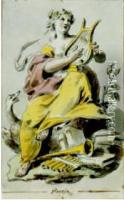Domenico De Angelis Paintings
Domenico De Angelis was an Italian artist, born in 1735 in Rome, Italy. He is primarily known for his work as a painter and architect during the 18th century, a period that was defined by the Rococo and early Neoclassical movements. De Angelis was a product of his time, embodying the artistic transitions of the era through his evolving style and contributions to both art and architecture.
Educated in the vibrant and historically rich atmosphere of Rome, De Angelis was exposed to the Renaissance and Baroque masters, whose influences are evident in his early works. However, as the Neoclassical movement gained momentum in the latter half of the 18th century, inspired by the rediscoveries at Herculaneum and Pompeii, De Angelis's work began to reflect these new classical ideals. His art started to embody the clarity, symmetry, and simplicity that Neoclassicism cherished, moving away from the ornate complexity of the Rococo style that marked his earlier years.
De Angelis was not only a painter but also took on architectural projects, showcasing his versatility and understanding of space and form. His architectural works are noted for their adherence to Neoclassical principles, emphasizing harmony and balance, and often incorporating Greco-Roman elements.
Throughout his career, Domenico De Angelis enjoyed the patronage of important figures of his time, which allowed him to work on significant projects across Italy. His contributions to the interior decorations of various churches and palaces are among his most celebrated works. These projects often featured frescoes and other decorative paintings that highlighted his skill in creating visually striking compositions that were both elegant and expressive.
De Angelis's legacy is that of an artist who successfully navigated the shifting artistic preferences of the 18th century, adapting his style to meet the evolving tastes of his era. His works remain a testament to the transitional period between Rococo and Neoclassicism, reflecting the intellectual and aesthetic currents of his time. Domenico De Angelis passed away in 1804, leaving behind a body of work that continues to be appreciated for its artistic merit and historical significance.













